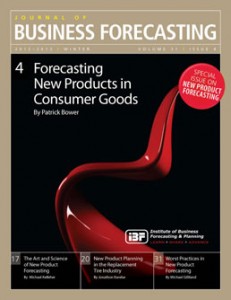New product forecasting is the most challenging activity in demand planning. It is also the most rewarding. It is challenging because new products have no history to go by, and rewarding because a large of portion of sales come from them—one-fifth according to the latest survey by the Institute of Business Forecasting and Planning. Accurate forecasts help to optimize the reward and minimize the
risk. This special issue of IBF’s Journal of Business Forecasting (JBF) on new product forecasting shows not only how to develop better forecasts, but also how to optimize the results.
Download a preview version of this special issue HERE.
Patrick Bower explains the process to be used for new product demand planning and forecasting. It begins by gathering input from Sales and Marketing, then deciding on assumptions about product distribution, velocity, cannibalization, and media/promotion plans. Subsequently, forecasts are prepared and demand plans are developed. Nothing is certain when it comes to new product forecasting. Therefore, the process should enable the Demand Planners to respond quickly to new information that arises prelaunch, during launch, and post-launch.
Michael Gilliland describes some worst practices in new product forecasting, thinking that if businesses realize what they are doing is wrong, they may do something about it. Many new product forecasts reflect nothing more than aspirations because they are generated either to pass the hurdle of approval or to tie forecasts with the management targets. He emphasizes that point forecasts are often developed, but the range forecasts along with them can provide additional information about risk involved.
Larry Lapide discusses demand signals drawn from the information gained from wholesalers, retailers, and consumers. This kind of data can be very helpful in developing new product forecasts. The job of Demand Planners does not end at the launch of a product. To assure its success, they need to follow the market feedback to see how it is doing; if anything needs to be fixed, it should be fixed right away. The author states that in addition to the market feedback from Sales and Marketing, Demand Planners can get valuable information from online ratings and reviews, such as seen on Amazon.com and various social media websites (for example, Facebook).
Jonathon Karelse describes how new product forecasting is done in the tire industry, which is very unique. In this industry, new product launches are few and far between, making branding difficult. As such, a large percentage of decisions are made by retail salesmen, not by consumers. What matters most in this industry is that new product developments and production timelines are consistent with the dealers’ expectations, while creating enough difference among products in the minds of consumers. (READ FULL ARTICLE)
Michael Kelleher shares his experience about new product forecasting and planning, which he regards as partly art and partly science. The art part includes investigating the assumptions made by Marketing in preparing the forecast. Is it a perfect or less-than-perfect forecast? Is this product viewed as revolutionary or evolutionary? And does this forecast take into account the availability of inventory? The science part includes searching for a real and unbiased forecast based on the past experience. He also describes
step-by-step what should be done before and after the launch. Demand planning and forecasting are important, but the success of new products will be further improved if the process of conceiving and developing them is sped up, because what matters is not just a new product and how it is marketed, but also which one is first. The first one gets a premium price and immediately gains a significant share of the market.
We encourage you to DOWNLOAD a preview version of this special issue HERE.


